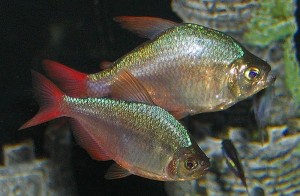The Colombian Tetra (Hyphessobrycon columbianus) also known to tropical fish keeping enthusiasts as the Blue Flame Tetra, Blue Red Tetra, and Colombian Red Fin Tetra is found only in the Río Acandí in Chocó Department, northern Colombia, close to the Panama border.
Originally misidentified as Hyphessobrycon ecuadorensis, the Colombian Tetra has a deep body that is silver colored with iridescent blue on the back and upper portion in both males and females.
The caudal and anal fins are a bright blood red color and the ventral fins are transparent to a light orange color. Sexually mature males are slightly smaller, more intensely colored, and develop a more extended dorsal fin than the females.
Colombian Tetras are a peaceful shoaling species that make ideal residents in a South American community aquarium. They should be housed with at least 8 to 12 of their own kind and get along well with other like sized schooling tetras.
Colombian tetras do best in a 30 gallon aquarium with a fine gravel substrate that is densely planted with fine leaved plants, some driftwood, moderate filtration, a slight degree of water movement, and plenty of swimming space.
Like many tetras, they are egg scatterers that exhibit no parental care after spawning. In a mature aquarium, they will often spawn spontaneously without intervention and occasionally a few fry can be observed.
To maximize the amount of fry that are produced, place a well conditioned adult group in a small dimly lit tank filled with aged water and a fine mesh carpet over the bottom that is large enough for the eggs to fall through, yet small enough so the adults cannot access the eggs. Many breeders use a commercially produced plastic grass like matting or a layer of marbles to cover the entire bottom of the tank. A less efficient but more natural media is a carpet of Dwarf Hairgrass or a bed of Java Moss on the bottom of an aged tank.
Regardless of what you use, the breeding tank should be filled with slightly acidic water with a pH at the lower range of 5.0 – 7.5, a temperature between 70 and 82 degrees F. and fitted with a seeded sponge filter or air stone to oxygenate the water and provide some water movement.
When a well conditioned group of one or two males and several females are introduced to the breeding tank, eggs will normally be observed the following morning. Spawning activity usually lasts anywhere from 2 to 4 hours and as many as 2000 eggs may be laid. Like most egg scatterers, the parents or spawning group should be removed from the breeding tank after spawning is completed or the eggs will be eaten.
Depending on the water temperature, the eggs will hatch in 24 to 36 hours. When the yolk sacs are absorbed, the fry should be fed infusoria or finely crushed flake food until they are large enough to accept microworms, Daphnia, or newly hatched baby brine shrimp.
In their natural habitat, Colombian Tetras are omnivores that feed on insects, worms, zoo-plankton, organic detritus, and small bits of plant material. In an aquarium environment, they should be given several small feedings of live, frozen, or freeze dried bloodworms, Daphnia, brine shrimp along with a quality omnivore flake food.
Colombian Tetras are sporadically available to tropical fish keeping enthusiasts when they are approximately 1 1/2″ – 2″ in length.
Minimum Tank Size: 30 gallons
Care Level: Easy
Temperament: Peaceful
Water Conditions: 73-80°F, 1-12°H, pH 5.0-7.0
Max. Size: 2 3/4″
Color Form: Blue, Red
Diet: Omnivore
Compatibility: Peaceful in small groups
Origin: Río Acandí, Colombia
Family: Characidae
Life Span: 3-5 years
Aquarist Level: Beginner




